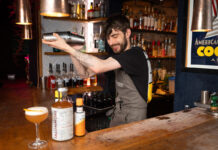SLTN asks Scottish spirits producers: what’s next for the category?

GIN’S rise in the on-trade has been nothing short of meteoric in recent years. And yet, despite the spirit’s continued success, the trends within the category remain, to some extent, in flux. So the question remains – what aspects of gin are on the up as we head into the new year?
While drinks firms told SLTN that gin will continue to prosper in 2020, it’s fair to say there’s some division on where the juniper-led spirit is heading next.
Sarah Fletcher, national account manager for St Andrews-based Eden Mill, said: “I believe a major growth category will be in gin RTDs and premiumisation.
“We have seen the growth in premium spirits, as well as the importance of speed of serve and consistency in bars and pubs; using pre-mixed RTDs takes away the risk of badly poured drinks.”
Liam Hughes, co-founder of The Glasgow Distillery, agreed that premiumisation will continue to play an important role in the gin category – but reckons the focus in 2020 will be on “the quality of the gin, the mixer and the garnish that accompanies it”.
Gin distillers are in a great position to take advantage of food and drinks trends.
Full-strength, London Dry-style gins could shine in the new year, according to Jill Smith, co-founder of Smithies Gin.
“From analysing our gin sales, we feel that full-strength London Dry-style are on the up instead of the liqueur side of the gin industry, which a few years ago had overtaken the full-strength gin sales in our shop,” said Smith.
“We feel people are now enjoying the full-strength, juniper-led gins instead of full on flavoured ones.”
However, others believe that flavoured gins will remain at the fore.
Chris Deacon, general manager of Maverick Drinks, distributor of Ableforth’s Bathtub Gin, said: “Fruit and flavour-led gins are continuing to drive the gin category as they are helping a wider audience discover a love for gin.”
Dale McQueen, managing director of McQueen Gin, agreed.
He said: “There will always be a place for good quality dry gins. However, what we’re seeing is more and more demand for different, seasonal flavour combinations.
“Gin distillers are in a great position to take advantage of food and drinks trends – and the market indicates that flavoured gins are only increasing in popularity.”
Flavoured gins are, according to Carlo Valente of Boë Gin parent firm VC2 Brands, also likely to remain popular due to their versatility in cocktails and long drinks.
“With flavoured gins gaining popularity and momentum in the market, the ‘ginaissance’ is in full swing, and consumers will expect to have a plethora of options to choose from at the bar,” added Valente.
While a raft of new flavoured gins have been released in 2019, the on-trade should expect many more in 2020, reckons Stephen Kemp of Kirkjuvagr parent firm Orkney Distilling.
He said: “Flavoured gins, which have been the best performing products within the category, will continue to grow – and it is likely that producers will become even more experimental with their releases; this year, we created Beyla: a raspberry and honey Old Tom gin.”
Low and no-alcohol spirits is another trend that’s likely to further infiltrate gin in 2020.
Fletcher of Eden Mill said it is a trend that “will continue to grow with mixologists and brands experimenting within this category”.
This view was reinforced by Diageo. A spokeswoman said: “Poor breadth of choice remains a barrier to entry, but innovation is fast addressing this.”
Ultimately, when it comes to updating a pub’s gin selection, Craig Rankin, distillery manager at Crafty Distillery, said: “If you’re looking for quality in your range, the top three things to ask yourself would be: where is it made? How is it made? Does it fit the premium nature of your establishment?”



















